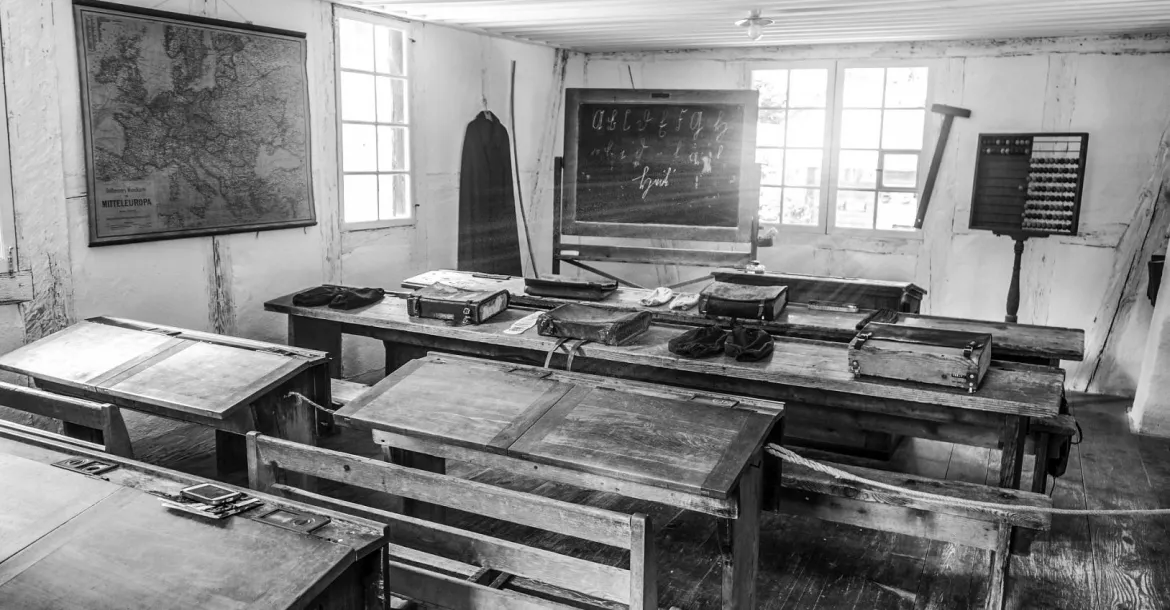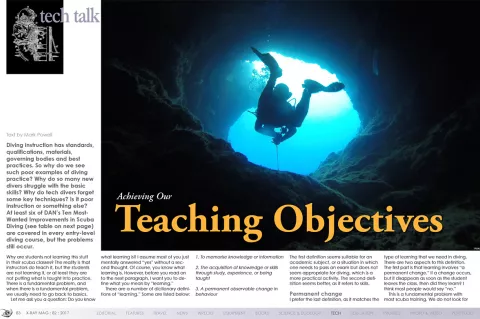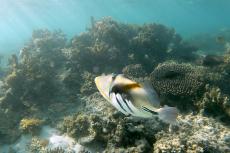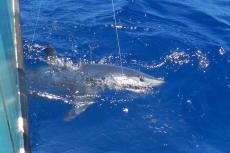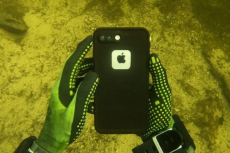Diving instruction has standards, qualifications, materials, governing bodies and best practices. So why do we see such poor examples of diving practice? Why do so many new divers struggle with basic skills? Why do tech divers forget some key techniques? Is it poor instruction or something else? At least six of DAN's Ten Most-Wanted Improvements in Scuba Diving (see sidebar) are covered in every entry-level diving course, but the problems still occur.
Contributed by
Factfile
DAN’S 10 MOST-WANTED IMPROVEMENTS IN SCUBA DIVING:
1. Correct weighting
2. Greater buoyancy control
3. More attention to gas planning
4. Better ascent rate control
5. Increased use of checklists
6. Fewer equalising injuries
7. Improved cardiovascular health in divers
8. Diving more often (or more pre-trip refresher training)
9. Greater attention to diving within limits
10. Fewer equipment issues/improved maintenance
Mark Powell is one of the leading technical diving instructors in the field.
He has been diving since 1987 and instructing since 1994, and is a full-time technical diving instructor for several leading agencies.
He teaches all levels up to and including Advanced Trimix.
In addition, he has led a number of expeditions to various parts of the world, including the Middle East, Costa Rica, Malta and the Red Sea, but is usually found diving the wrecks around the coast of the United Kingdom.
For more information on any aspect of technical diving, visit: Dive-tech.co.uk.
Why are students not learning this stuff in their scuba classes? The reality is that instructors do teach it, but the students are not learning it, or at least they are not putting what is taught into practice. There is a fundamental problem, and when there is a fundamental problem, we usually need to go back to basics. Let me ask you a question: Do you know what learning is? I assume most of you just mentally answered “yes” without a second thought. Of course, you know what learning is. However, before you read on to the next paragraph, I want you to define what you mean by “learning.” There are a number of dictionary definitions of “learning.” Some are listed below:
- To memorise knowledge or information
- The acquisition of knowledge or skills through study, experience, or being taught
- A permanent observable change in behaviour
The first definition seems suitable for an academic subject, or a situation in which one needs to pass an exam but does not seem appropriate for diving, which is a more practical activity. The second definition seems better, as it refers to skills.
Permanent change
I prefer the last definition, as it matches the type of learning that we need in diving. There are two aspects to this definition. The first part is that learning involves “a permanent change.” If a change occurs, but it disappears as soon as the student leaves the class, then did they learn? I think most people would say “no.” This is a fundamental problem with most scuba training. We do not look for permanent change. If the student can perform the skill right now, then we tick off that skill on a checklist and move on to the next. There is no consideration as to whether the student will be able to perform the skill in a week, or a month, or under stressful situations. This is a critical aspect, but one we will have to return to in a later article.
Observable change
The second aspect of the definition calls for an “observable change in behaviour.” It is critical that we understand what change in behaviour we are looking for. If we do not know what change we are looking for, how will we know if we achieve it? However, many instructors believe (or have been taught) that teaching involves following a process. If they follow the correct process, then they have taught the student. That may be true; they may have taught, but it does not mean the student has learnt. I have often seen instructors become frustrated because their students “just don’t get it.” When asked what they mean by “it,” the instructor struggles to answer. They may not be able to answer, but they are confident that they will recognise “it” when they see “it.” This is a one of the key mistakes in teaching. Without knowing exactly what you are trying to achieve, it is difficult to put a plan in place to achieve it.
Learning objectives
This is where the idea of a learning objective, or a learning outcome, comes from. The learning objective is the “observable change in behaviour” we are looking for. In other words, we start with the end in mind. Determine what change we are looking for, and then determine how we can achieve that change. A learning objective is a deceptively simple concept. We just need to come up with a specific testable change that we want to see. This is easy to say, but like many skills, it takes practice. Common mistakes made may include making the objective too general or impossible to test. Another common mistake is one in which the objective focuses on what the instructor will do, when it should focus on what the student will be able to do. To avoid some of these problems, a good way to structure an objective is to put it into the following format:
- “By the end of this session, you will be able to _________.”
- (Wherein the blank represents the objective.)
This can be used to detect poor objectives. For example:
- “Today, I am going to talk about decompression theory.”
- “In this pool session, we will go through mask clearing.”
In both cases, the emphasis is on the instructor, or the process. There is no focus on the behaviour of the student. Using the structure suggested above, we can refocus these aims on the student. For example:
- “By the end of this session, you will know all about decompression theory.”
- “By the end of this session, you will have mastered mask clearing.”
This is better. The aims are focused on the student. But are these realistic objectives? Knowing all about decompression theory is a hugely ambitious goal, which would take years to achieve. This is just not feasible. Of course, most instructors would say that they did not mean “all about decompression theory.” They just meant “the relevant parts of decompression theory to the relevant level.” Which then begs the question: What are the relevant parts and what is the relevant level?
Testable objectives
We can be more specific by focusing on the second condition—that the objective should be testable. How will we test that the objective has been met? How will we prove that the behaviour has been achieved? We can do this by focusing on the actual change in behaviour that we want. “Knowing” is not a change in behaviour and is not a productive word to use in an objective. Equally, “understand,” “learn,” “respect” or “appreciate” are too vague to be used in an objective. These are internal mental states, whereas the objective should give the external behaviour, or action, we are looking for. Consequently, the objective should use an action or “doing” word, such as “explain,” “list,” “assemble,” “define,” “calculate,” “plan,” “analyse,” “describe,” etc. We can use a more appropriate “doing” word to create a more specific behaviour. For example:
- “By the end of this session, you will be able to list two factors that affect our No Decompression Limit.”
- “By the end of this session, you will be able to clear a flooded mask.”
By structuring the objective in this way, it makes it much easier to test whether the students have achieved the objective. The objective is the behaviour we want them to achieve. So, we just ask them to demonstrate that behaviour. For example:
- “Now that we have completed the decompression theory section, can you list the two factors that affect our No Decompression Limit?”
The behaviour described by the objective will vary depending on the level of the course. For example, the level of decompression knowledge expected of an open water diver will be very different to that expected of a technical diver. See the following:
- Open Water:
- “By the end of this session, you will be able to list two factors that affect our No Decompression Limit.”
- Trimix:
- “By the end of this session, you will be able to describe the impact changing the high and low gradient factors will have on our decompression profile.”
It is essential that we have a realistic expectation of the behaviour we want from the diver. Expecting the same proficiency in mask clearing from open water divers on their first pool sessions versus their last open water dives is unrealistic, as is expecting the same level of proficiency of an open water diver and a divemaster candidate. We also need to look at the conditions under which we want the skill performed. Students clearing their mask while kneeling on the bottom of a pool may be appropriate for the first pool session, but by the end of the pool sessions, and certainly by the time the students are in open water, we want them to be able to clear their masks while neutrally buoyant. These are the conditions in which they may need to perform the skill when in the real world, so our objective should be to ensure that they can achieve the skill under these conditions:
- “By the end of this session, you will be able to clear a flooded mask while maintaining neutral buoyancy.”
Performance level
The last thing to consider is the level of performance that is acceptable. If the student is being asked to clear his or her mask while neutrally buoyant, then what level of variation would be considered acceptable? How many attempts or breaths would be considered acceptable? This will be linked to the audience; again, you would expect a different degree of performance from an open water student and a divemaster trainee or technical diving instructor candidate. For example:
- Open water student:
- “By the end of this session, you will be able to clear a flooded mask within three attempts, while maintaining neutral buoyancy, to within plus or minus 1m (3ft) of your starting position.”
- Divemaster trainee/technical diving instructor candidate:
- “By the end of this session, you will be able to clear a flooded mask with a single attempt, while maintaining neutral buoyancy, to within plus or minus 0.5m (1.5ft) of your starting position.”
When setting learning objectives, consider: • Audience • Behaviour • Conditions • Degree Learning objectives are the closest thing we have as instructors to a magic wand. If you can construct a specific, testable objective that is appropriate for the level of the student, then it makes it much easier for you to structure the lessons required to achieve that objective. It makes it easier for students to understand what they are being asked to achieve, and it makes it easier for the student and instructor to tell whether the student has achieved the required level. All of this makes for a much more productive learning environment, and makes it much more likely that the teaching carried out by the instructor results in learning by the student. ■

